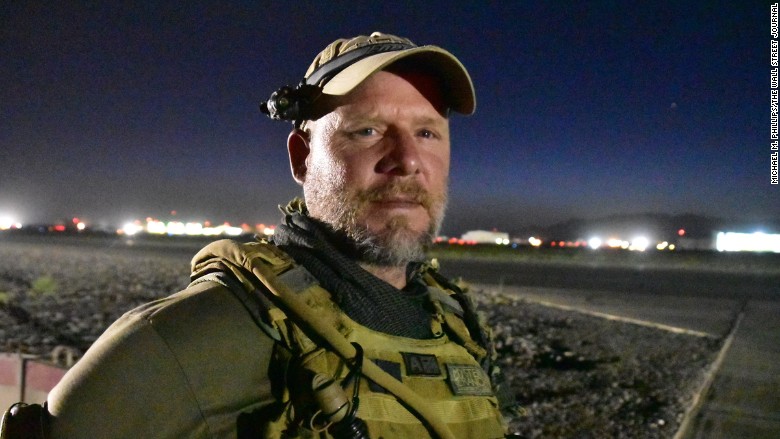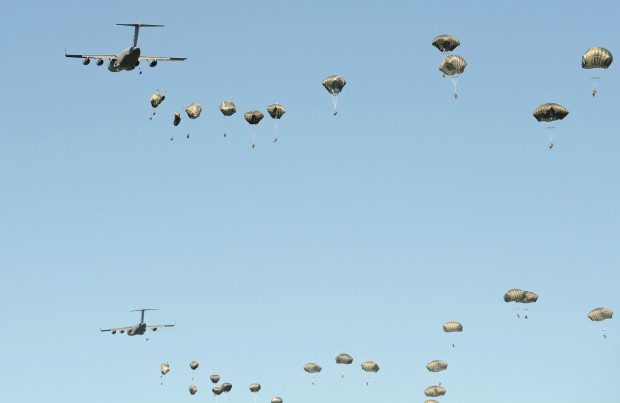Two members of an NPR news crew, David Gilkey and Zabihullah Tamanna, were killed on Sunday while traveling in southern Afghanistan.
CNN: “They were traveling with an Afghan army unit when the convoy came under fire. Their vehicle was struck by shell fire,” according to a statement by NPR.
Two other NPR crew members, correspondent Tom Bowman and producer Monika Evstatieva, “were in a following vehicle,” NPR head of news Michael Oreskes told CNN. “Tom and Monika were not hurt.”

Sunday’s attack marks the first time in the 46-year history of NPR that one of its journalists has been killed on assignment.
Gilkey, 50, was an award-winning staff photographer and video editor for NPR. In the 15 years since the 9/11 attacks, he returned time and time again to Afghanistan and other conflict zones.
“David was profoundly committed to coverage of both Afghanistan and Iraq,” Oreskes said. “He wanted to know what was happening to the people there. I think that’s why he kept going back — because he wanted to understand what was happening to the soldiers and civilians.”
Watchdog: Afghanistan’s lapis lazuli is a ‘conflict mineral’
FNC: KABUL, Afghanistan – An international anti-corruption watchdog says Afghanistan’s war is being fueled by the country’s mining sector, with armed groups — including the Taliban — earning $20 million from illegal mining of lapis lazuli.
A report by Global Witness released on Monday says that lapis lazuli, a blue stone almost unique to Afghanistan, should be classified as a “conflict mineral.”


It says the northern Badakhshan province where lapis lazuli is concentrated has been “deeply destabilized” by violent competition for control of the mines between local strongmen, law makers and the Taliban.
Badakhshan is a microcosm of what is happening across Afghanistan, with mining being the Taliban’s second biggest source of income, after drugs.
The Taliban insurgency is in its 15th year.
Afghanistan’s mineral assets are believed to be worth billions of dollars.
How Obama’s Afghanistan plan is forcing the Army to replace soldiers with contractors
WaPo: Current restrictions on U.S. troop levels in Afghanistan and a heavy reliance on civilian contractors are eroding the skills and cohesion of units deployed to the country, according to information from the Army given to the House Armed Services Committee and provided to The Washington Post.
According to an Army document, the use of civilian labor in one of the Army’s combat aviation brigades, or CABs, in Afghanistan has had negative side effects because the contractors are being used in lieu of the brigade’s maintenance soldiers. Those soldiers should be deploying with their units, but are not because of the “constrained troop level environment” in Afghanistan, the document says.


[Obama faces what is likely his last major decision on the Pentagon’s role in Afghanistan]
“Aviation maintainers not deploying with their [brigades] results in an erosion of skill and experience essential to soldier and leader development,” Army officials said in the document. “The atrophy of these critical skills erodes the brigade’s ability to deploy in the future and sustain itself in an expeditionary manner to locations that may not permit the deployment of contractors.”
According to the Army document, three CABs have deployed to Afghanistan since 2013 with reduced maintenance staffs. A typical CAB usually deploys with 1,500 soldiers but can swell above 2,500 depending on the mission. In 2013, a brigade deployed with 1,900 troops, but as U.S. forces were reduced in Afghanistan, a brigade of only 800 deployed in 2015. Despite the reduction in troop levels, the brigade was still expected to maintain and fly its roughly 100 aircraft.
Currently, the 4th Infantry Division’s CAB is deployed to Afghanistan and provides “country-wide aviation support,” according to a breakdown of U.S. forces in Afghanistan that was compiled by the Institute for the Study of War. It primarily provides rotor-wing support in the form of helicopter gunships and transports.
According to the Army document, only 6 percent of the 4th’s CAB is dedicated to maintaining aircraft. That small number is specifically for recovering aircraft that land or crash in a hostile environment. Instead, 427 civilian personnel — at a cost of $101 million annually — are maintaining the CAB’s fleet of helicopters. Through 2014 and 2015, 390 contractors maintained both the 101st and 82nd Airborne Divisions’ aircraft for $86 million when their CABs were deployed to Afghanistan.
While U.S.-led combat operations in Afghanistan officially ended in 2014, last fall, as the Taliban gained momentum throughout the country, President Obama agreed to keep about 9,800 U.S. troops in Afghanistan through 2016, and 5,500 into 2017.
Although the troop levels are low compared to the 45,000 deployed at the start of 2014, the number of uniformed service members in Afghanistan is only part of the U.S. war effort there. As of April, 26,000 Pentagon contractors are in Afghanistan, about half of whom are assigned to logistics and maintenance duties, according to publicly available reports.
[In Afghanistan, a series of attacks on Americans during ‘non-combat’ operations]
Although the number of contractors has almost always exceeded the number of uniformed troops in Afghanistan, the ratio of civilian employees compared to U.S. military personnel has more than doubled in the past two years, from 1.34 to 2.92.
“I am not at all convinced that the only units affected are the combat aviation brigades,” Rep. Mac Thornberry (R-Tex.), chairman of the House Armed Services Committee, said in a recent interview. “Aside from financially … is there a potential that it increases the risk that our folks face just because of these political limits? Those questions are certainly worthy of a significant deep dive on the part of the committee.”
***** Obama being asked about force levels:
Washington, DC- Senator Tom Cotton (R-Arkansas) and nine members of the Senate Armed Services Committee sent a letter to President Obama regarding U.S. troop levels in Afghanistan. “A timely decision on U.S. force levels is necessary so that our allies and partners can generate forces and make appropriate pledged for the Resolute Support Mission beginning in January 2017,” the bipartisan group of senators wrote. “We urge you to announce any changes to our current planned force levels ahead of the relevant NATO conferences, giving the strong consideration to the assessment of your military commanders and to conditions on the ground.”
The letter was signed by Senator Tom Cotton (R-AR), Senator John McCain (R-AZ), Chairman of the Armed Services Committee, Senator Joe Manchin (D-WV), Senator Kelly Ayotte (R-NH), Senator Jeanne Shaheen (D-NH), Senator Deb Fischer (R-NE), Senator Joe Donnelly (D-IN), Senator Tim Kaine (D-VA), Senator Lindsey Graham (R-SC), and Senator Angus King (I-ME).
The text of the letter can be found below. Additionally, click here to read the letter.
Dear President Obama:
We appreciate your continued willingness to consider adjustments based on the security situation in Afghanistan to preserve and build upon the hard fought gains achieved over the past 14 years. In recent months, the Senate Armed Services Committee has heard from General Nicholson, General Campbell, and General Votel – the senior military commanders closest to the fight – that the security situation in Afghanistan is deteriorating, which challenges the ability of the Afghan government to provide stability and security for its people.


We understand that General John Nicholson is in the process of completing his assessment of the capabilities and associated troop levels he believes will be necessary in Afghanistan to confront a resurgent Taliban, a reviving Al Qaida, and a rising Islamic State in Iraq and the Levant, and will make recommendations in the near future. As the Commander on the ground, we believe that his recommendations should be given extraordinary weight. We also believe that the withdrawal of U.S. forces from Afghanistan should be based on conditions on the ground and that considerations on troop levels should be driven first by what capabilities are needed to protect our national security interests in Afghanistan, and second by the number of troops it takes to enable those capabilities.
Furthermore, the North Atlantic Treaty Organization (NATO) will hold its Force Generation Conference beginning on June 8th and the NATO Summit in Warsaw will begin on July 8th. It is important that our allies and partners understand any changes to our planned force levels for Afghanistan before those key events to determine and plan for the number of troops they will commit to operations in Afghanistan in 2017. As has long been the case, we believe our NATO Allies and partners will follow our lead in Afghanistan. In February, General Campbell testified to Congress that “If our number continues to go down, NATO will absolutely reduce their commitment to Afghanistan.” Additionally, we do not think we are going to learn anything in the next several months that we do not know now. Should you decide to revise the planned number of U.S. troops in Afghanistan for 2017, we urge you to announce such a decision before the relevant NATO conferences convene and inform our partners and allies of that decision so they can plan accordingly.
In summary, a timely decision on U.S. force levels is necessary so that our allies and partners can generate forces and make appropriate pledges for the Resolute Support Mission beginning in January 2017. We urge you to announce any changes to our current planned force levels ahead of the relevant NATO conferences, giving the strongest consideration to the assessment of your military commanders and to conditions on the ground.
Sincerely,
Senator John McCain
Senator Joe Manchin
Senator Kelly Ayotte
Senator Jeanne Shaheen
Senator Deb Fischer
Senator Joe Donnelly
Senator Tom Cotton
Senator Tim Kaine
Senator Lindsey Graham
Senator Angus King





